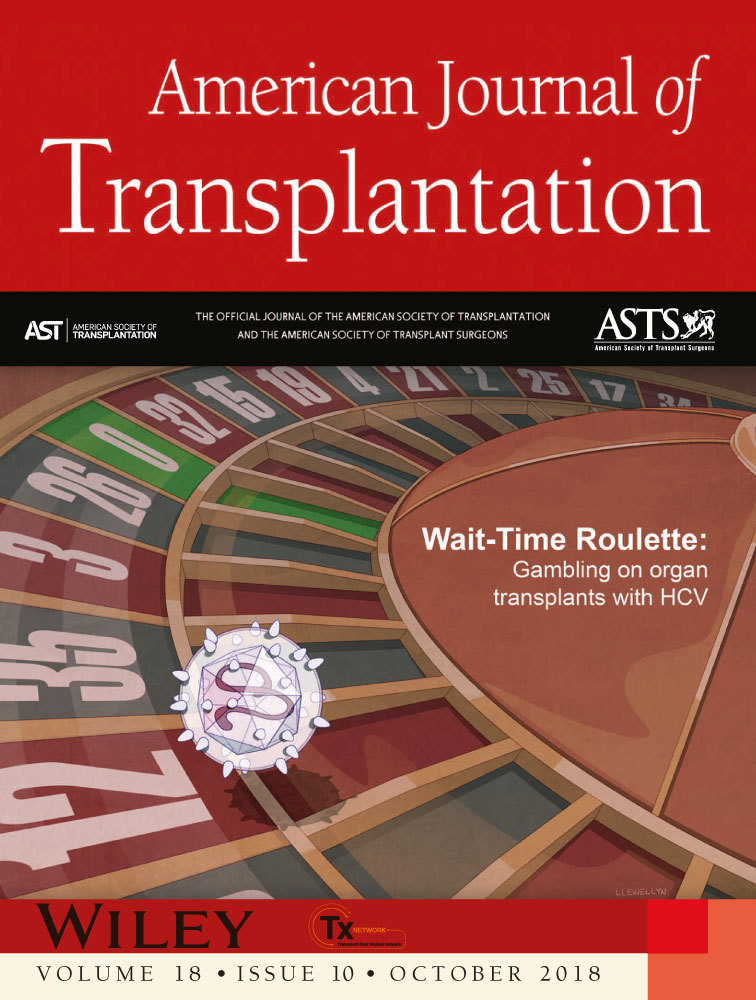Maximizing utilization of the donor pool by appropriate classification of hepatitis C antibody–positive donors
See also: de Vera et al
Abstract
In this editorial, the authors highlight recent work from de Vera et al (page 2451) regarding the transplantation of kidneys from HCV antibody–positive donors to HCV-negative recipients that should increase provider confidence in the safety of using these organs.
Hepatitis C virus (HCV) is unlike other viruses commonly encountered in organ transplantation (eg, cytomegalovirus, hepatitis B virus [HBV]), in that up to one-third of immune-competent hosts acutely infected with HCV spontaneously clear the infection.1 Such patients will have a detectable HCV antibody (Ab), a marker of exposure to HCV, yet a detectable HCV RNA signifies active infection. Unlike HBV, where a core Ab is associated with viral reservoirs in the liver that can reactivate, an isolated HCV Ab does not confer immunity to reinfection or a risk of viral reactivation. The presence of an HCV Ab does not qualify a patient as being “increased-risk” unless other behaviors are present.
Donor HCV serologic testing has evolved over time, with mandatory HCV antibody and nucleic acid testing (NAT) instituted in January 2014. In August 2015, DonorNet allowed centers to select patient willingness to accept an organ from a donor with the following: (a) positive HCV antibody; and/or (b) detectable qualitative HCV NAT. An HCV Ab+/NAT- donor reflects one of several scenarios, including: false-positive antibody, active infection with fluctuating low levels of virus, or previous infection with HCV cure (via medical treatment or spontaneous clearance). The overwhelming majority of HCV Ab+/NAT- donors fall into the category of prior infection with spontaneous clearance.1 The presence of an HCV antibody with negative NAT testing in and of itself does not confer an increased risk of transmission, but rather the risk is proportional to the donor's increased risk behavior (eg, intravenous drug use) and the temporal relationship between the behavior and donor serologic testing. Despite this, utilization of kidneys from HCV Ab+/NAT- donors has mirrored that of actively infected donors.2
There has been recognition that organs from HCV Ab+/NAT- donors represent an underutilized and increasing resource for HCV-negative patients. Nevertheless, there have been concerns about the potential risk of HCV transmission in liver transplant recipients from an HCV Ab+/NAT- donor.3 Whether such risks exist in nonhepatic transplants, and whether bias was introduced due to a small sample size, has left open this question. Thus the work of De Vera and colleagues is so timely.4 Over a 13-month period, Loma Linda performed 32 kidney transplants (25 deceased donors) in HCV-negative patients from HCV Ab+/NAT- donors. The transplanted kidneys had above average measures of “graft quality” and 31 of 32 kidneys were from outside the center's donor service area. Due to the long cold-ischemic times from importing kidneys (median cold ischemic time was 23.5 hours), 15 (47%) of recipients had delayed graft function, and one had primary nonfunction, but 1- and 3-month renal function was good in almost all recipients.
There were no episodes of HCV transmission after a mean follow-up of 10.0 ± 2.7 months, with 27 patients reaching the 6-month mark. Of interest, 14 (44%) patients seroconverted (positive HCV antibody) posttransplant, with persistent HCV seropositivity in 14/27 (51.9%) patients followed for at least 6 months. These data suggest that although HCV seroconversion is common, actual viral transmission is rare, and does not mirror published data from the field of liver transplantation. Without repeated HCV NAT tests, it is not possible to say with 100% certainty that viral transmission did not occur; however, the probability of spontaneous HCV clearance in the setting of immunosuppression is exceedingly low.
These data are important and should increase provider comfort in utilizing kidneys from HCV Ab+/NAT- donors, but must be taken in context. The sample size of 32 transplants, the largest published to date, is still small. Even with an HCV transmission rate of 0%, the sample size of 32 yields a 95% confidence interval of 0%-10.9%. Second, the mechanism by which recipients developed an HCV Ab could not be explained. The authors provide several hypotheses, including passive Ab transmission or an immune response to HCV antigens in the donor kidney. Although the former explanation is more likely in the setting of profound immunosuppression, more data are needed to determine why seroconversion occurs. Nevertheless, only detectable HCV RNA in the recipient qualifies as a definite viral transmission, and thus it may be reasonable to consider only testing for HCV RNA in recipients of organs from Ab+/NAT- donors to avoid confusion over the clinical significance of an HCV Ab in the absence of detectable HCV RNA in the recipient. Such considerations should be taken in context given the limited data to suggest that Ab transmission alone lacks clinical significance, an important area of future research.
Recent changes in United Network for Organ Sharing (UNOS) policy require explicit consent at the time of organ offer when accepting an HCV viremic donor. Policy does not, however, require additional consent for HCV antibody–positive donors, although centers may choose to discuss these tests with potential recipients ahead of transplant. Data from De Vera and colleagues can help guide such educational efforts, as can UNOS data since 2015 that demonstrates no cases of HCV transmission from HCV Ab+/NAT- donors who did not also have public health service increased-risk behaviors.5 Ultimately, for centers and their recipients looking to expand the potential pool of suitable donors, considering HCV Ab+/NAT- donors appears to be a very safe option.
DISCLOSURE
The authors of this manuscript have conflicts of interest to disclose as described by the American Journal of Transplantation. DG received consulting fees from Merck and received research funding from Merck for studies of transplantation of organs from HCV-infected donors into HCV-uninfected recipients. CW has no conflicts of interest to disclose.




